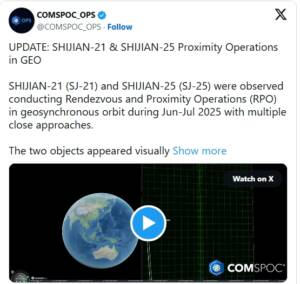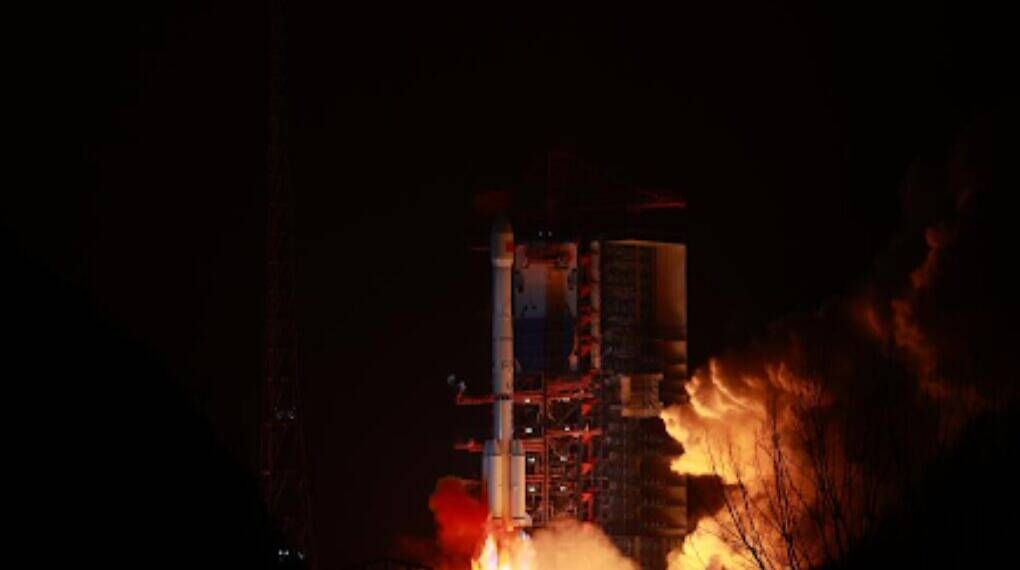In a stunning display of technological advancement, China has reportedly completed the world’s first satellite-to-satellite refueling mission in geosynchronous orbit (GEO), marking a historic leap in its space capabilities and overtaking long-time space powers, the United States and Russia.
According to reports from several sources, including the South China Morning Post and U.S.-based space situational awareness firm COMSPOC, two Chinese satellites—Shijian-21 and Shijian-25—successfully docked and likely conducted an orbital refueling operation approximately 35,786 kilometers above Earth.
A Historic First in Space
Between July 2 and July 6, optical sensor data indicated that the two Chinese satellites “appeared visually merged,” suggesting successful docking. These operations, formally known as Rendezvous and Proximity Operations (RPO), began as early as June 11, when Shijian-25 began maneuvering steadily toward Shijian-21.

By June 13, the satellites came within one kilometer of each other and continued a series of close approaches throughout the month. Images and tracking data from Swiss firm S2A Systems corroborated these findings, showing repeated proximity maneuvers leading up to the docking event.
The Shijian-25, launched in January 2025 by the Shanghai Academy of Spaceflight Technology, was specifically designed for satellite refueling and life-extension technology verification. The Shijian-21, launched in 2021, had previously moved a defunct BeiDou navigation satellite to a graveyard orbit and had expended much of its fuel, making it the ideal target for a refueling test.
Though Chinese authorities have not formally confirmed the refueling, observers believe confirmation could come if Shijian-21 begins executing new maneuvers, signaling a successful fuel transfer.
Technical and Strategic Significance
Refueling satellites in geosynchronous orbit represents a formidable technical challenge. Unlike operations in low Earth orbit (LEO), GEO-based refueling involves extreme distances, complex microgravity docking, and ultra-precise control systems—all without human intervention.
If confirmed, the success would give China a powerful edge in orbital sustainability, potentially reducing the need for costly satellite replacements and enabling a network of orbital servicing satellites.
“This kind of mission demonstrates a leap in long-term space sustainability and autonomy,” said a spokesperson from COMSPOC. “It also signals China’s maturity in managing complex space logistics.”
Dual-Use Concerns Stir U.S. Anxiety
While technologically impressive, the mission has raised alarms among U.S. defense analysts and policymakers, who see the move as having significant dual-use potential. In addition to peaceful applications, such refueling technology could also be adapted for military use, such as extending the operational life of surveillance satellites or disabling adversary systems in orbit.
“China is very good at dual-use,” said Robert Hall, Director of Special Projects at COMSPOC. “Naturally, DoD sees this, and it makes the hairs on the back of people’s necks stand up.”
With refueled satellites capable of longer missions and greater maneuverability, the implications for intelligence gathering, electronic warfare, and anti-satellite (ASAT) operations are profound.
U.S. Lags Behind in GEO Refueling
Although the U.S. has previously demonstrated satellite refueling in LEO—most notably during DARPA’s Orbital Express mission in 2007—it has yet to achieve a similar feat in GEO. Despite growing recognition of the need for in-orbit logistics, U.S. investment remains minimal.
For fiscal year 2026, the Pentagon’s budget allocates only $14.5 million to the Space Access, Mobility & Logistics program, down nearly 50% from FY2025. This includes all RPO and refueling efforts, highlighting a lack of prioritization compared to China’s rapidly advancing initiatives.
Commercial projects such as Tetra-5 and Tetra-6, aimed at testing similar technologies, are not scheduled for launch until 2026 and 2027, respectively, leaving the U.S. firmly in a catch-up position.
A New Era of Space Power
The Shijian mission reflects China’s broader space strategy: self-reliance, sustainability, and long-term dominance. Managed by the People’s Liberation Army Strategic Support Force and the China National Space Administration (CNSA), the operation illustrates how Beijing is integrating space innovation with national security objectives.
If confirmed, this milestone could mark the beginning of a new era of orbital logistics and infrastructure—a domain where China appears to be pulling ahead.
As the geopolitical space race intensifies, one thing is clear: the battle for supremacy is no longer just about reaching space—it’s about staying there, sustaining operations, and ensuring strategic dominance for decades to come.








